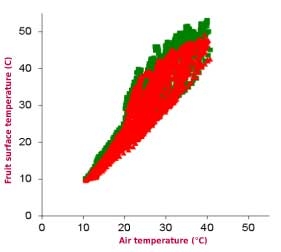Installation of netting is a long-term investment, but will it have a long-term benefit? Installation of netting by apple growers has been a widespread response to combat adverse weather events. RESULTS (continued from last month)
Results
Fruit surface temperature
Maximum daily fruit temperatures were consistently higher in non-netted areas of the block compared with netted areas (Figure 3 – see Tree Fruit August 2013).
Over the monitoring period, the maximum fruit surface temperature recorded in the non-netted area was 54.1C. By contrast, the maximum fruit surface temperature recorded under netting was 49.6C.
A greater proportion of sensors installed in the non-netted area recorded fruit surface temperatures in excess of 46C (85%) than under netting (45%), and 10 % of sensors in the non-netted area recorded temperatures in excess of 52C.
Fruit surface temperatures exceeded orchard air temperature by as much as 17.5C in the non-netted area and by 14.3C under netting.
Air temperature
Air temperature (within the block or outside the block) was a strong predictor of maximum fruit surface temperature (Figure 4).
However, when air temperature exceeded 20C, variability of fruit surface temperature increased.
Increased variability of fruit surface temperature in response to increasing air temperatures above 20C supports previous conclusions that air temperature alone is inadequate for accurate prediction of fruit temperature.
However, our data indicate that fruit are at risk of sun damage when air temperatures exceed 28C (non-netted orchards) or 33C (netted orchards), based on a 46C threshold fruit temperature.
Sun damage assessments at harvest showed differences between non-netted and netted areas (Table 1).
There was little difference in the occurrence of minor browning between non-netted and netted trees, however, occurrence of more severe forms of sun damage (major browning and necrosis) and damage caused by sudden exposure to light (photooxidative damage) appeared to be higher in the non-netted trees than under netting.
Microclimate
A comparison of weather data from the non-netted and netted areas of the block demonstrates the effects of netting on microclimate.
Air temperature was similar within the non-netted and netted orchard areas (Figure 5).
The perception of lower air temperatures under netting is due to shading; the decrease in solar radiation hitting our skin when we stand under netting means we are cooler, even though air temperature is unchanged.
The effect is the same for apples; lower fruit temperatures under netting are largely attributable to lower solar radiation exposure.
Global, diffuse, UV-B and photosynthetically active radiation were all lower in the netted orchard than in the non-netted area.
Measurements showed that netting reduced UV-B radiation by 30% whereas photosynthetically active radiation was reduced by 22%.
Reductions in UV-B radiation and photosynthetically active radiation are likely to have contributed to the reductions seen in sun damage.
Reductions in photosynthetically active radiation can limit yield by decreasing the production of assimilates by photosynthesis, however, no evidence was seen of this at this site.
Different netting products will have differing impacts on the light environment of an orchard.
Conclusion
The observed fruit temperature responses under netting and sun damage assessments at harvest confirm the effectiveness of netting in reducing, but not preventing, sun damage under current conditions.
Fewer fruit under netting reached temperature thresholds for occurrence of sunburn browning (46C to 49C). Fruit under netting did not reach temperature thresholds for sunburn necrosis (52C).
At the study site, netting substantially reduced development of major sunburn browning, necrosis and photooxidative damage.
A very low proportion (less than 1%) of the fruit grown under netting would have been culled due to sun damage, and approximately 8% would have been downgraded due to minor sun damage.
This contrasts markedly with the non-netted area of the orchard, where up to 6% of fruit would have been culled due to sun damage and 10% would have been downgraded.
Next
In the next step of this project, the data will be used to verify and if necessary, modify existing fruit surface temperature models.
Following model verification, simulations will be run for 2050 and 2070 climate scenarios to evaluate the potential for netting to continue to provide effective sun protection in the future.
Corresponding author phone 0358335260
email:
Acknowledgements
This project was conducted as part of the apple and pear industry’s climate change research and extension program and funded by HAL using the apple and pear industry levy and matched funds from the Australian Government. Additional financial support was provided by DEPI Victoria. We thank Geoffrey Thompson Orchards for permitting us to use their orchard.
See all tables and graphs in Tree Fruit September 2013




















